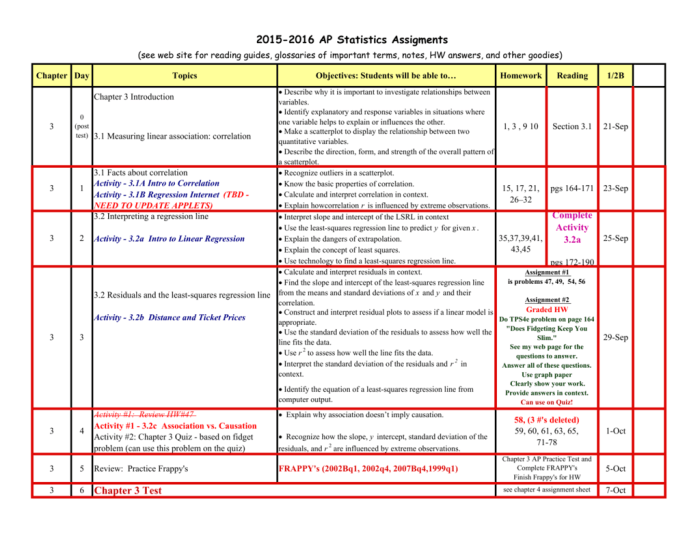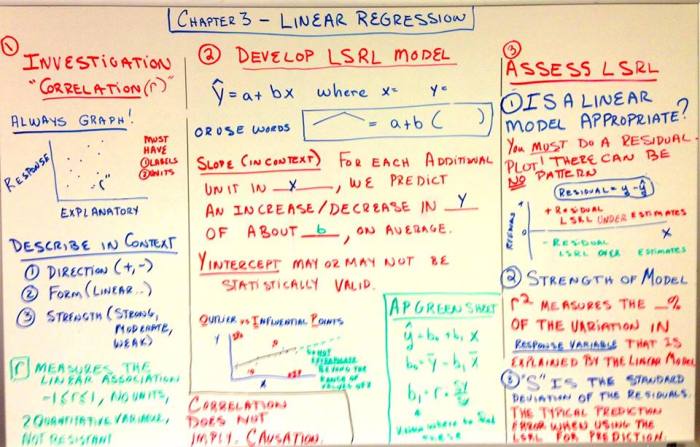Ap stats chapter 3 test answer key – AP Statistics Chapter 3 Test Answer Key: A Comprehensive Guide to Statistical Concepts delves into the fundamental principles of statistical vocabulary, distributions, measures of central tendency, and variability, equipping readers with a thorough understanding of these crucial statistical concepts.
This guide provides a detailed overview of the statistical vocabulary and notation used in AP Statistics Chapter 3, ensuring that readers have a solid foundation for comprehending and interpreting statistical data. It also explores the various types of distributions and their characteristics, enabling readers to identify and analyze different data patterns.
Statistical Vocabulary and Notation

Understanding statistical vocabulary and notation is essential for success in AP Statistics. Key terms include:
- Population:The entire group of individuals or objects being studied.
- Sample:A subset of the population that is used to make inferences about the population.
- Variable:A characteristic that can take on different values for different individuals or objects.
- Data:The values of a variable for a sample or population.
- Statistic:A numerical measure that describes a sample.
- Parameter:A numerical measure that describes a population.
Statistical notation is used to represent variables, data, statistics, and parameters. For example, the mean of a sample is represented by x̄, and the standard deviation of a population is represented by σ.
Understanding statistical vocabulary and notation is important because it allows you to communicate effectively with other statisticians and to understand the results of statistical analyses.
Describing Distributions
A distribution is a graphical or mathematical representation of the values of a variable. There are many different types of distributions, but the most common are the normal distribution, the binomial distribution, and the Poisson distribution.
The normal distribution is a bell-shaped distribution that is symmetric around the mean. The binomial distribution is a discrete distribution that describes the number of successes in a sequence of independent experiments. The Poisson distribution is a discrete distribution that describes the number of events that occur in a fixed interval of time or space.
It is important to understand the shape and center of a distribution because these characteristics can tell you a lot about the data. For example, a normal distribution with a high mean indicates that the data is clustered around the mean.
A binomial distribution with a low probability of success indicates that successes are rare.
Measures of Central Tendency
Measures of central tendency are numerical measures that describe the center of a distribution. The three most common measures of central tendency are the mean, the median, and the mode.
The mean is the average of all the values in a distribution. The median is the middle value in a distribution. The mode is the value that occurs most frequently in a distribution.
Each measure of central tendency has its own advantages and disadvantages. The mean is the most commonly used measure of central tendency because it is easy to calculate and it is a good measure of the overall center of a distribution.
However, the mean can be affected by outliers, which are extreme values that are far from the center of the distribution. The median is not affected by outliers, but it can be difficult to calculate for large data sets. The mode is the easiest measure of central tendency to calculate, but it is not always a good measure of the center of a distribution, especially for distributions that are not symmetric.
Measures of Variability: Ap Stats Chapter 3 Test Answer Key
Measures of variability are numerical measures that describe how spread out a distribution is. The three most common measures of variability are the range, the variance, and the standard deviation.
The range is the difference between the largest and smallest values in a distribution. The variance is the average of the squared differences between each value in a distribution and the mean. The standard deviation is the square root of the variance.
Each measure of variability has its own advantages and disadvantages. The range is the easiest measure of variability to calculate, but it is not a very precise measure. The variance is a more precise measure of variability, but it is more difficult to calculate.
The standard deviation is the most commonly used measure of variability because it is a good compromise between precision and ease of calculation.
Comparing Distributions

There are many different ways to compare distributions. The most common methods are graphical methods, such as histograms and box plots, and numerical methods, such as the Kolmogorov-Smirnov test and the chi-square test.
Graphical methods are a good way to visualize the differences between two distributions. Histograms show the distribution of values in a data set, and box plots show the median, quartiles, and outliers in a data set.
Numerical methods are a more formal way to compare distributions. The Kolmogorov-Smirnov test is a non-parametric test that compares the cumulative distribution functions of two distributions. The chi-square test is a parametric test that compares the expected and observed frequencies of values in a data set.
It is important to be able to compare distributions because it allows you to determine whether two distributions are different from each other.
Frequently Asked Questions
What is the purpose of the AP Statistics Chapter 3 Test Answer Key?
The AP Statistics Chapter 3 Test Answer Key provides comprehensive answers and explanations for the questions in Chapter 3 of the AP Statistics textbook, helping students assess their understanding of statistical concepts.
What topics are covered in AP Statistics Chapter 3?
AP Statistics Chapter 3 covers statistical vocabulary and notation, describing distributions, measures of central tendency, and measures of variability.
How can I use the AP Statistics Chapter 3 Test Answer Key effectively?
To effectively use the AP Statistics Chapter 3 Test Answer Key, students should first attempt the questions in the textbook and then refer to the answer key to check their answers and identify areas for improvement.